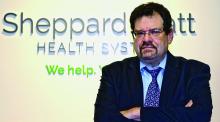WASHINGTON – Successfully treating patients who have treatment-resistant depression (TRD) means leaving acute intervention behind and adopting more chronic remediation techniques, Scott T. Aaronson, MD, said at the annual conference of the Anxiety and Depression Association of America.
“We need to change the paradigm; most of the research is looking at a 6- to 12-week outcome measure,” said Dr. Aaronson, director of the clinical research program at Sheppard Pratt Health System, Baltimore. “These are folks who have been depressed for most of their adult lives, and we don’t tend to take a longer-term perspective when looking at this.”
Treatment-resistant depression, Dr. Aaronson said, can be conceptualized as two levels. The first is failure of two agents or treatments, and the second is a failure of four or more agents – including electroconvulsive therapy. In light of those levels, Dr. Aaronson suggests approaching depression as one would cancer, with different stages of failure determining payment for more expensive treatments.
Before planning how best to handle treatment-resistant depression, it is important for psychiatrists to understand its complexity, and address the issues associated with current psychiatric diagnoses, Dr. Aaronson said.
Diagnoses now are based purely on phenomenological analysis rather than biological analysis, he said. “Basically, it’s a room full of people getting together to decide what the diagnostic criteria are,” Dr. Aaronson said. “It’s eminence-based medicine, not evidence-based medicine.”
This approach creates a large gray area in which diagnoses can fall, making it more difficult to distinguish between bipolar and unipolar depression, as well as tough to distinguish psychotic and nonpsychotic illnesses.
If a patient displayed mood instability, for example, but not enough to fit the criteria of bipolar disorder, this scenario would present a dilemma for psychiatrists unable to diagnose the patient as bipolar and unconvinced that it would help to treat the patient as only being depressed, according to an example from Dr. Aaronson.


